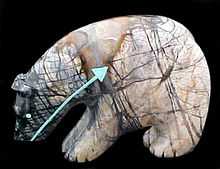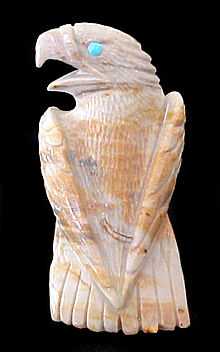Zuni fetishes



Zuni fetishes are small carvings made from various materials by the Zuni people. These carvings have traditionally served a ceremonial purpose for their creators and depict animals and icons integral to their culture. As a form of contemporary Native American art, they are sold with secular intentions to collectors worldwide.
Traditional description
According to the Second Annual Report of the Bureau of Ethnology as submitted by Frank Hamilton Cushing in 1881, and posthumously published as Zuni Fetishes in 1966, the Zuni world is made up of six regions or directions. At the center of each region is a great mountain peak that is a very sacred place. Yellow mountain to the north, blue mountain to the west, red mountain to the south, white mountain to the east, the multi-colored mountain above, and the black mountain below.[1]
Each direction is represented by a "Prey God", or guardian animal, and are listed by Cushing as follows: north—the yellow mountain lion, west—the black bear (represented by the color blue), south—the red badger, east—the white wolf, the sky or upper—the multi-colored eagle, and the underground or lower—the black mole. Each prey god is the "guardian and master" of their region with the yellow mountain lion being the elder brother of all animals and the master and guardian of all regions. Each one of these regions contains an order of all the guardian animals, but the "guardian and master" of a particular region is the elder brother to all animals of that region. These guardians are considered as having protective and healing powers. They are held by the priests of the medicine orders as if "in captivity" and act as mediators between the priests and the animals they represent.[2]
A second group of fetishes, the "Prey Gods of the Hunt", belonging to the Hunter Order, or Society, are given in the "prayer songs of the Sa-ni-a-kia-kwe". These guardian animals are the same as the original regions with the exception of the coyote, which replaces the bear; and the wildcat (or bobcat), which replaces the red badger (Cushing, 1994:20). Sa-ni-a-kia is the awakening of the fetish and subsequently the power of the hunter (Cushing, 1994:15).
Typically Zuni fetishes depict animals such as the wolf, badger, bear, mountain lion, eagle, mole, frog, deer, ram, and others. There are many more subjects of contemporary carvers that may include dinosaurs, for example, that would be considered non-traditional, or some insects and reptiles that are traditionally more integral to petroglyphs, symbolism, and the patterns of design in pottery, e.g. dragonflies and butterflies, water spiders, and lizards (See Bunzel,1929, and Young, 1988). Other animals, such as the horse, were carved mainly for trade. The Zuni was not a horse culture but their horse carvings were considered by the horse cultures to the north as having great power for the protection of their herds (Cushing, 1994, Bahti's Introduction).
Materials
Traditionally, the materials used by carvers were often indigenous to the region or procured by trade. The most important of these materials was turquoise which the Zuni regard as the sacred stone. Jet, shell (primarily mother-of-pearl), and coral are also frequently used. These materials and their associated colors are principle in the Zuni sunface, a cultural symbol which is present in Zuni jewelry and fetishes and represents their sun father. Other materials used are travertine or "Zuni rock", fishrock, jasper, pipestone, marble, or organic items such as fossilized ivory, bone, and deer or elk antler. Even artificial substances such as slag glass are used. But historically the most-used stone has been serpentine, a local soft stone found abundantly in the Zuni Mountains and also in Arizona In recent years Zuni carvings, or fetishes, have become popular collectibles and Zuni artisans have familiarized themselves with materials available from all parts of the world in order to serve the aesthetic tastes of collectors.[3]
Sacredness
In tradition, each animal is believed to have inherent powers or qualities that may aid the owner. The Navajo, for example, treasured and bartered for figures of horses, sheep, cattle or goats to protect their herd from disease and to ensure fertility (Cushing, 1994, Bahti's Introduction). The Zuni hunter, or "Prey brother," was required to have his fetishes (prey gods of the hunt) with a "Keeper" and practice a ceremony of worship when procuring a favorite or proper fetish to aid in a successful hunt. In the ceremony of the hunt the Keeper presented a clay pot containing the fetishes to the hunter. Facing in the direction appropriate to the chosen fetish the pot was sprinkled with medicine meal and a prayer was recited. The fetish was placed in a buckskin bag and carried by the hunter over his heart (Cushing, 1994:33). The fetish aids in the chase and represents "the roar of the animal" and is also fed on the blood of the slain prey.[4]
In addition to the Prey Gods of the Six Regions with their guardian and medicinal powers, and the Prey Gods of the Hunt that aid in the chase, Cushing names three Prey Gods of the Priesthood of the Bow, a society of which he was a member, that aid a Priest of the Bow when traveling in a region where he may be captured by the enemy. These are the mountain lion and great white bear, which belong to the "skies", as well as a prey god of human form adorned with "flint knife-feather pinions and tail". An arrowhead, "emblematic of Sa-wa-ni-kia", or the "medicine of war", on the back or side of either of these animals prevented a warrior from being taken by surprise by his enemy, and an arrowhead on the belly or feet erased the tracks of the carrier so that they could not be followed by the enemy. Unlike the Prey Gods of the Hunt these fetishes were never deposited with a keeper, but like the Prey Gods of the Hunt they were fed on the blood of the slain and their ceremony involved depositing sacred flour to the four directions and reciting a prayer, and like the Prey Gods of the Six Regions they were protective of the carrier (Cushing, 1994:40-43).
On the subject of feeding, it is believed from tradition that the fetishes require a meal of cornmeal and ground turquoise periodically. Fetishes may be kept in a clay pot as it is the tradition, although collectors usually like to keep theirs somewhere where they can be admired. Any but the very delicate fetishes could be carried by the owner in a pocket, pouch or bag.
Religion as art
The artist's styles are as unique as the artists themselves, and there are many whose works are highly sought after by collectors. Some collectors prefer a figure that is more realistic in appearance, while others prefer the more traditional styles that are intrinsic to Zuni belief. The traditional belief of the Zuni is that the least modification of the original material maintains, or heightens, the power of the fetish as a "natural concretion" (Cushing, 1994:12). Realism in carving style is a matter relative to the beliefs of its owner, and the realism in contemporary carving is a product of collector request and demand and the intent of Zuni carvers to raise the level of their art form through participation in the world of contemporary art. The enigma, or apparent paradox relevant to Zuni belief and realism in art is resolved in the notion that carvings for sale and collection are produced without religious intent. For this reason some carvers prefer the term "carvings" rather than the term "fetishes" when referring to offerings for collectors.
A fetish may be signed by the carver, or not. Personalization by signing a piece of art traditionally violates the Zuni notion of community purpose, and the signing of artwork is a concept introduced to the Zuni by Anglo collectors at the beginning of the twentieth century (c. 1915). Often, though, a Zuni carver feels that their own unique style is readily identifiable and the fetish's style will be enough to identify the carver as surely as would any other mark. Most carvers are the recipients of a family tradition and have learned their skill from parents, grand parents, or siblings, and have passed the art to their own children as well.
Besides being made from various stones and other materials (each material has unique properties), the contemporary fetish may carry an offering of a smaller animal or a prayer bundle of carved arrowheads with small beads of heishe. It may be adorned with a heishe necklace, feathers, etchings representing ancient petroglyphs, or an etched or inlaid heartline. These small items, although colorful to the eye, are intended to protect and feed the fetish itself.[5]
Notes
References
- Bunzel, Ruth L. (1929). The Pueblo Potter: A Study of Creative Imagination in Primitive Art. ISBN 0-486-22875-4
- Cushing, Frank Hamilton (1994). Zuni Fetishes. Tenth printing. Reprint of the Second Annual Report of the Bureau of Ethnology, 1883. Introduction by Tom Bahti. ASIN B000TH8P4C
- Finkelstein, Harold (1994). Zuni Fetish Carvings. ISBN 0-9641042-0-2
- McManis, Kent (1998). A Guide To Zuni Fetishes & Carvings, Volume II, The Materials and the Carvers. ISBN 1-887896-11-2
- Young, M. Jane (1988). Signs from the Ancestors: Zuni Cultural Symbolism and Perceptions in Rock Art. Albuquerque: University of New Mexico Press. ISBN 0-8263-1203-9
Further reading
- Cushing, Frank Hamilton, Mark Bahti (1999). Zuni Fetishes. Reprint of the Second Annual Report of the Bureau of Ethnology, 1883. Introduction by Tom Bahti. ISBN 0-88714-144-7..
- McManis, Kent (1995). A Guide To Zuni Fetishes & Carvings. ISBN 0-918080-77-0
- McManis, Kent (1998). A Guide To Zuni Fetishes & Carvings, Volume II, The Materials and the Carvers. ISBN 1-887896-11-2.
- Riggs, David Austin, Darlene Meader Riggs (2008). ZUNI SPIRITS: A Portfolio of Fine Zuni Fetish Carvings. Introduction by the Zuni Governor, Norman Cooeyate.